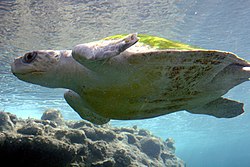| Mexichelys Temporal range: Late Campanian | |
|---|---|
| Scientific classification | |
| Domain: | Eukaryota |
| Kingdom: | Animalia |
| Phylum: | Chordata |
| Class: | Reptilia |
| Order: | Testudines |
| Suborder: | Cryptodira |
| Superfamily: | Chelonioidea |
| Family: | Cheloniidae |
| Genus: | Mexichelys Parham & Pyenson, 2010 |
| Species | |
| |
| Synonyms | |
Euclastes coahuilaensisBrinkman et al., 2009 | |
Mexichelys is an extinct monotypic genus of sea turtle which lived in Mexico during the Cretaceous. The only species is Mexichelys coahuilaensis. [1] Mexichelys was erected in 2010 as a replacement name for Euclastes coahuilaensis, a species named in 2009. [2]
Cladogram based on Lynch and Parham (2003) [3] and Parham and Pyenson (2010): [1]
| Cheloniidae sensu lato |
| ||||||||||||
